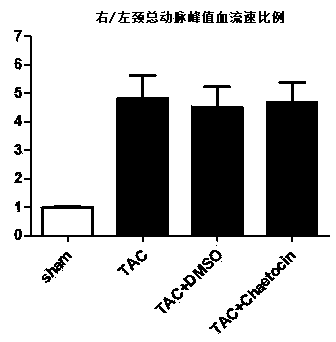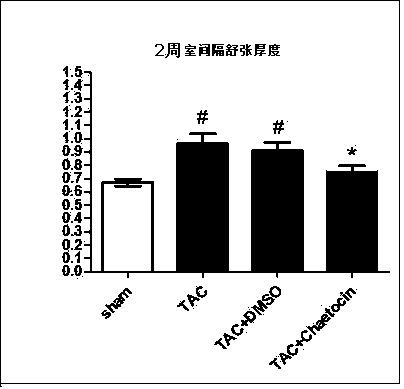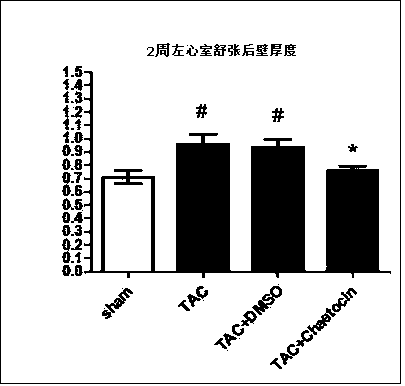Application of chaetocin in preparation of medicine used for preventing and treating heart diseases
A technology of chitin and heart disease, applied in the application of chitin in the preparation of drugs for preventing and treating heart disease, in the field of chitin compounds, can solve problems such as no research reports, and achieve prevention and treatment of heart disease, prevention and treatment Cardiac disease, the effect of inhibiting oxidative stress in cardiomyocytes
- Summary
- Abstract
- Description
- Claims
- Application Information
AI Technical Summary
Problems solved by technology
Method used
Image
Examples
Embodiment 1
[0048] Example 1 Protective effect of chaetocin on pressure load-induced ventricular remodeling
[0049] 1. Experimental grouping and experimental methods:
[0050] SPF grade male C57BL / 6 mice (purchased from the Model Animal Institute of Nanjing University, the same below) were selected and randomly divided into four groups for 6 to 8 weeks: sham operation group (Sham), operation group (TAC), operation + solvent control group (TAC+DMSO), operation+administration group (TAC+Chaetocin), 6 to 8 rats in each group. Mice were artificially ventilated after anesthesia, the thorax was opened at the 2nd to 3rd intercostal space on the left side of the chest, the aortic arch was separated, the aortic arch (Transverse aortic constriction, TAC) was narrowed according to the uniform standard, and the thorax was closed. Except that TAC was not performed in the sham operation group, the rest of the operation procedure was exactly the same as that of the model group. The solvent control gro...
Embodiment 2
[0060] Example 2 Myocardial protection experiment of chaetocin on acute injury
[0061] 1. Experimental grouping and experimental methods:
[0062] Male C57BL / 6 mice of SPF grade were selected and randomly divided into three groups for 6 to 8 weeks: sham operation group (Sham+DMSO), myocardial infarction group (MI+DMSO), myocardial infarction+administration group (MI+chaetin Chaetocin), 18 to 20 per group. Mice were artificially ventilated after anesthesia, and the thorax was opened at the 2nd to 3rd intercostal space on the left side of the chest, and the left anterior descending coronary artery (Blocking Left Anterior Descending Coronary Artery, LAD) was ligated according to uniform standards to make an acute myocardial infarction model and the thorax was closed. In the sham operation group, except that LAD was not performed, the rest of the operation procedure was exactly the same as that of the model group. In the myocardial infarction group and the myocardial infarction ...
Embodiment 3
[0073] Example 3 Experiment of the effect of chaetokinin on primary cardiomyocytes
[0074] 1. Experimental method:
[0075] The method of culturing primary cardiomyocytes in vitro is as follows: After 1 to 3 days of clean grade SD suckling mice were killed by cervical dislocation, the apex of the heart was taken, digested and centrifuged, and placed in 15% serum DMEM medium, 37°C, 5% carbon dioxide incubator The medium was changed after 36-48 hours of cultivation. After the cardiomyocytes were pretreated with chaetokinin with increasing concentration, the cardiomyocytes were given H 2 o 2 (in vitro simulation of oxidative stress) or antimycin A (AA) and 2-deoxyglucose (2-DG) (in vitro simulation of cardiomyocyte ischemia model). After harvesting the cells, lyse the whole protein and do Western Blot experiment.
[0076] 2. Experimental results
[0077] Depend on Figure 22 , 23 The experimental results show that in H 2 o 2 Or under the stimulation of antimycin A (AA) ...
PUM
 Login to View More
Login to View More Abstract
Description
Claims
Application Information
 Login to View More
Login to View More - R&D
- Intellectual Property
- Life Sciences
- Materials
- Tech Scout
- Unparalleled Data Quality
- Higher Quality Content
- 60% Fewer Hallucinations
Browse by: Latest US Patents, China's latest patents, Technical Efficacy Thesaurus, Application Domain, Technology Topic, Popular Technical Reports.
© 2025 PatSnap. All rights reserved.Legal|Privacy policy|Modern Slavery Act Transparency Statement|Sitemap|About US| Contact US: help@patsnap.com



